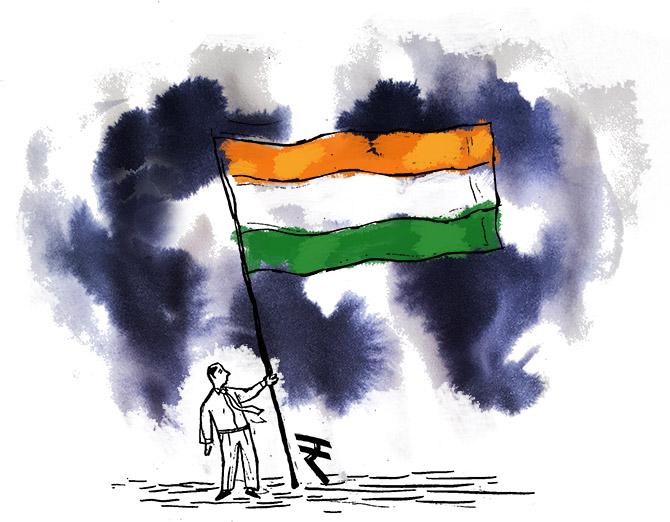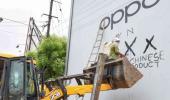'India's future: To manufacture so efficiently that we do not need protection,' says Naushad Forbes.
Illustration: Dominic Xavier/Rediff.com

Sociologist Ronald Dore was a great scholar of Japan. During a visit to Delhi in the early 1980s, he wrote a paper on self-reliance in India, sub-titled Sturdy ideal or self-serving rhetoric. It provides us with both the direction of what we must do to make self-reliance work (the sturdy ideal), and a clear warning of what to stay away from (the self-serving rhetoric).
Dore's essential argument was that India needed to learn from the best in the world, that this learning required a systematic and considerable effort, and that in matters of self-reliance, learning mattered more than creating.
Dore was writing at a time when self-reliance was key to Indian economic policy. It condemned us to sub-standard goods, sold at a high price.
Remember that every new Premier Padmini or Ambassador we bought -- with a five-year waiting list -- was a 20-year-old design, and that the Indian Airlines published a timetable for the sole purpose of allowing passengers to calculate how late they were.
India in the 1970s was a miserable place. We must not go back there.
Launching a policy of self-reliance, the prime minister referred to two medical items (PPEs and N95 masks) in his first speech. And speaking at the Confederation of Indian Industry annual general meeting, he asked why we imported 30 per cent of the air-conditioners sold in the country.
All three examples have one thing in common: Imports from China.
We export $15 billion worth of goods to China each year, mainly raw materials such as iron ore.
We import $75 billion worth of goods from China (the Covid virus was supplied free), almost all manufactured goods, equal to around one-fifth of our national manufacturing output.
China is a manufacturing superstar, with depth of supply chains across items.
The government says this rediscovered self-reliance is outward-looking. But how can a policy that relies on tariff protection against imports be outward-looking?
How can self-reliance help deliver a vibrant and competitive manufacturing sector?
These questions have rekindled an old debate: Are we better off with a regime of tariffs and import substitution, or a regime of trade liberalisation and export promotion?
Which of these will build globally competitive firms?
There is much for us to learn from the experience of Japan, South Korea and Taiwan in the 1950s-1970s.
At the heart of self-reliance is tariff protection.
Make no mistake: A tariff on imports is a tax on consumers, who pay more than they would without the tariff.
How do we justify such a tax on ourselves? Only if the tax is temporary, five years, say, and results in a world-competitive industry that needs no further protection -- an industry the country would not otherwise have.
The government has imposed a tariff on both ACs and the components that go into them -- compressors, controllers, evaporators, and such.
A good phased manufacturing programme has a defined time-frame for the protection to go to zero. Instead, we have the tariff increasing over time to 30 per cent from the current 20 per cent for the finished AC and from 10 per cent to 20 per cent for components.
Should the Indian consumer really be expected to pay 30 per cent more than the world price five years from now?
And the schedule of tariff reduction must be fully credible. Taiwan used tariff protection across many industrial sectors in the 1960s, 1970s and 1980s -- textiles, steel, plastics, consumer electronics, semiconductors. All of those were successful in establishing globally competitive industries, as the tariff protection went away.
Their experience with cars was different -- protection was provided in the 1960s and early 1970s. The State then opened up the car market as scheduled -- in spite of protests from local industry that it would be wiped out (it was, but subsequently every other industry believed more strongly in the period of protection).
So, we need a phased tariff reduction for ACs to zero, and we need it announced transparently ahead of time and stuck to so firms know exactly what to expect and can invest with confidence in a clear and unchanging policy.
Tariffs always have to be removed before firms are entirely ready to deal with the removal -- competitiveness cannot be a choice left to firms.
Japan, South Korea and Taiwan are models for both the advocates of import substitution and export promotion.
Any thoughtful study of Japanese industrialisation in the 1950s and 1960s, and South Korea and Taiwan's industrialisation in the 1960s and 1970s show how the governments actively intervened in protecting domestic firms. But they did so in a very special way. Firms often received protection in return for committing to specific export targets.
In Taiwan, for example, firms had to export over half their output -- if these targets were not met, the protection was removed. The great advantage of exporting is that it forces competitiveness, with all manner of beneficial feedback from demanding buyers.
Firms must also learn what product features are in particular demand -- features which may take time to develop, and which prepare the firm for future demand at home as well.
Competitiveness is a reflection of what firms do, and firms respond to price signals and incentives. Making an AC compressor efficiently is a matter of learning. And learning, as Dore pointed out, takes conscious effort.
When Hyundai Motors started making its first vehicles in 1968, they learnt how to manufacture efficiently by repeatedly disassembling and assembling the sample cars they had imported.
Samsung did the same when they started making microwaves as a supplier to GE and eventually emerged as the world's largest manufacturer.
Self-reliance for essential medical supplies, such as PPEs and N95 masks, during a global health emergency is a fine example of how idealism and challenge can deliver extraordinary results.
Some weeks ago, when a team at CII started working on the supply chain, India produced zero PPEs and N95 masks. Thanks to an extraordinary response from small and large Indian industry, we are today the world's second largest manufacturer of PPEs (500,000 per day) and are now considering exports.
The supply chain of raw materials is also local. And the import tariff on masks and PPEs' Zero -- as it should be.
This is India's future: To manufacture so efficiently that we do not need protection.
Self-reliance must be our sturdy ideal, not self-serving rhetoric to justify protection.
Naushad Forbes is co-chairman, Forbes Marshall; past president CII; chairman of Centre for Technology Innovation and Economic Research, and the Ananta Aspen Centre.











